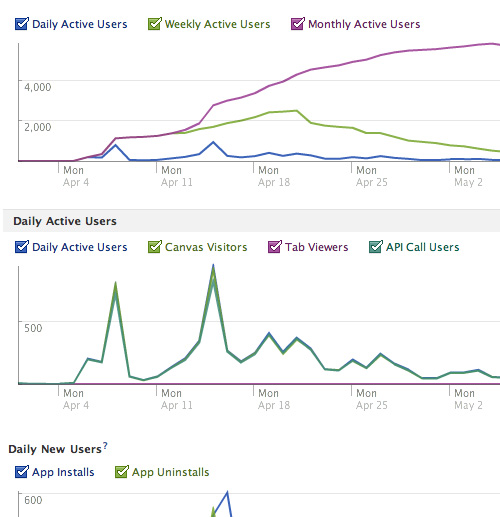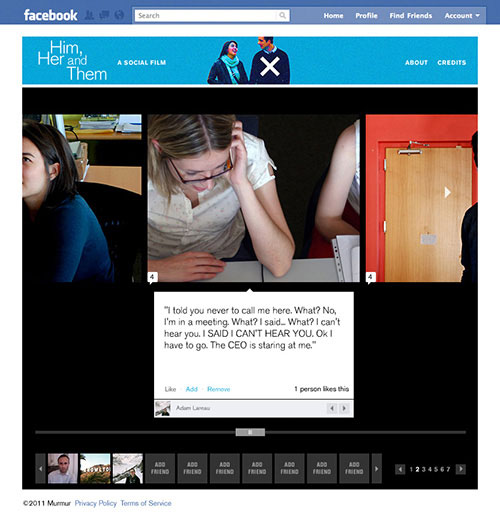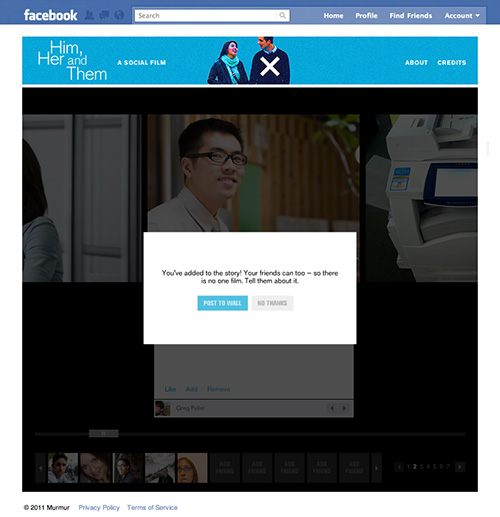How do you make your film go viral? That may be one of the questions that filmmakers ask most these days. And today we have the answer for you… sort of.
Hal Siegal guest posted here awhile back and today he explains the concept and practice of social loops. If you want people to engage and share with your work, you best read up now.
In my previous post regarding my experimental social film, HIM, HER AND THEM, I mentioned that I’ve been spending a lot of time thinking about “social loops”. So what the heck is a social loop, anyway? It’s not just an academic or rhetorical question—an understanding of social loops is absolutely critical for any filmmaker looking to build or engage an audience through the use of social media.
The notion of a social loop is derived from the term “viral expansion loop”. These loops or “hooks” are a key driver of the massive growth of many web 2.0 companies including Facebook, Twitter and YouTube, and more recently casual game companies like Zynga. However, the concept is not new: Tupperware parties were an early example of a viral loop in action. A viral expansion loop uses specific ideas from biology that describe the spread of viral diseases and combines this with the more generalized concept of a positive feedback loop (compounding interest in a bank account is the classic example of positive feedback: interest payments add to your balance and the result in turn increases the amount of interest).
What does a social loop look like? Consider the way Facebook works. Facebook is absolutely useless to you unless your friends are on it. Once a few friends have joined it is somewhat useful, and as more friends join, it becomes more useful—and the same thing is true for each friend in turn. The point here is not just that this creates growth, but that it can create exponential growth. (Note that this is just one simple example. Facebook incorporates many loops and even levels of loops—a social game like Cityville contains another set of loops built on top of Facebook itself).
It seems that filmmakers are beginning to understand the potential value inherent in social loops. For example, in support of his latest film NEWLYWEDS, Ed Burns held a crowdsourced poster contest and song contest. At their core, these types of contests employ a simple social loop: a participant submits an entry and then naturally encourages all his or her friends to vote for it. That’s the first half of the loop. The second half is where the friends learn about the contest and then submit their own entries, thus starting the loop over again (and this is where this particular example breaks down—the set of people interested in a given film + having the skills to create a decent original poster or piece of music is relatively small. Filmmakers would be wise to consider other types of social engagement that have lower barriers to entry).
Of course, efforts like these still fall into the realm of marketing. With HIM, HER AND THEM, we took the next step and added a social loop into the film experience itself. This took the form of simple text additions that viewers and their friends could add to the film, thereby customizing and altering it. But of course these text additions are only meaningful if your friends can see them. So viewers are encouraged to invite friends to also watch and add to the film, and in turn they invite their friends to watch and add—and there’s the loop.
Since the film was released as a Facebook application, we are able to measure our audience engagement in ways that would be impossible in a traditional film. So how did we do with our first project? Our results were mixed. First the positive:
– We had approximately 6,000 viewers in the first month (with zero marketing dollars behind it)
– Of these, 50% interacted with the film socially in some way (by liking, sharing or commenting)
– 25% added to the story
– Average number of visits per user: 2. We assume that most people were viewing the film once, then returning to see what they friends added.
And now the negatives:
– We lost approximately 50% of our inbound viewers at the Facebook Permissions prompt. Ouch. We attribute this to the fact that a large number of inbound links were generated by StumbleUpon where users had no context that this was a Facebook application. This shows the importance of contextualizing your links and marketing. It also shows the hurdle that the Facebook Permissions screen represents—we did predict that this would be an issue.
– We had a lowly 3.33% conversion rate of friend requests to confirmations. This was very disappointing. We attribute it to Facebook’s new notification process and the fact that we weren’t able to invite friends via status updates on their walls or via email (in their defense, Facebook made the changes because social games were getting quite spammy with regards to email and wall notifications).
– Finally, viral growth is measurable as mathematical formula known as the viral coefficient. For growth to be viral, the coefficient has to be greater than 1. Ours was .07. That’s not so great in terms of growth and nowhere near exponential growth. In fairness though, this first project was largely a proof of concept. For our next projects we are thinking about deeper and more sophisticated social loops that will be specifically tailored to the nature of the story.

Social loops are clearly powerful, but the challenge is to use them with consideration and not in an exploitative manner (game mechanics face a similar challenge right now). Designed poorly, social loops will be perceived as a crass and manipulative tool. Designed well, with clear value and meaning for the user, social loops can be a gateway to entirely new kinds of engagement. This is our goal as we explore the possibilities of social films.
—
Hal Siegel is a partner in Murmur, a hybrid studio/technology company that creates and distributes social films. He wrote and directed HIM, HER AND THEM.




